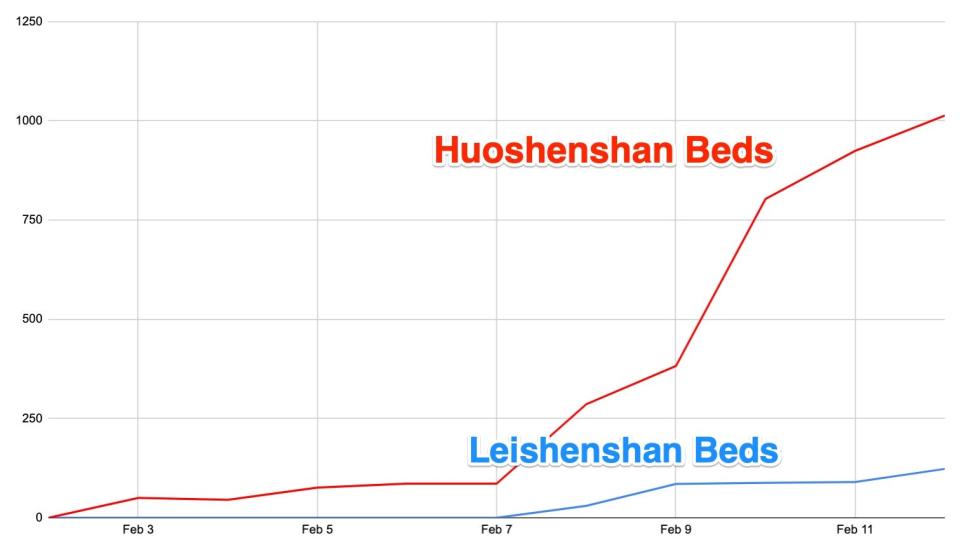China boasted that it built 2 new coronavirus hospitals in 12 days. But they're treating less than half the people they're supposed to.
China seemed to score a major victory in its fight against the coronavirus by building two new hospitals in an extremely short time, promising 2,600 new beds.
Chinese state media lauded the lightning-speed construction of the makeshift hospitals, saying it reflected the "nation's building prowess."
Official data, however, shows the facilities have been slow to treat patients.
As of February 12 the two facilities were housing 1,136 patients — less than half of their goal.
The virus has killed at least 1,360 people and infected more than 60,000, with the Wuhan area the worst-hit.
It was probably China's biggest propaganda coup of the coronavirus outbreak: announcing and building two new hospitals in a time frame that was almost incomprehensible in the West.
Chinese state media livestreamed frantic construction efforts as first the Huoshenshan and then the Leishenshan hospitals sprang up out of nowhere, the first built in 10 days and the second in 12.
They were to provide sorely needed new beds for victims of the outbreak: 1,000 at Huoshenshan and 1,600 at Leishenshan.
—China Xinhua News (@XHNews) February 7, 2020
China's official Xinhua news agency called the quick turnaround "Mission Impossible made possible." Cameras toured the fresh-built facilities and noted that patients were being moved in already.
Official data, however, shows that the utility of the hospitals has yet to match the pace or spectacle of their construction, with the facilities running at less than half their projected 2,600 capacity.
Here is a graph showing the number of occupied beds reported each day by local officials:

Business Insider/Google
This chart shows the raw figures:
Date | Leishenshan Beds | Huoshenshan Beds |
Feb 2 | 0 | 0 |
Feb 3 | 0 | 50 |
Feb 4 | 0 | 45 |
Feb 5 | 0 | 76 |
Feb 6 | 0 | 86 |
Feb 7 | 0 | 86 |
Feb 8 | 30 | 286 |
Feb 9 | 85 | 382 |
Feb 10 | 88 | 803 |
Feb 11 | 90 | 924 |
Feb 12 | 123 | 1,013 |
CAPACITY | 1,600 | 1,000 |
The hospitals combined had only 1,136 beds occupied out of a possible 2,600 beds available by Wednesday.
It is not clear what is responsible for the mismatch between the hospitals' notional capacity and the reality.
According to The Guardian, elsewhere in the city there is a dire shortage of space, with exhibition centers and sports halls being converted into makeshift medical sites.
The virus has killed at least 1,360 people and infected more than 60,000. Most of the cases have been recorded in China's Hubei province, where Wuhan is the largest city.

Getty
On Thursday, Hubei officials reported an enormous spike in cases: 14,840 new infections.
Earlier this month, officials said that major hospitals had to turn away patients because they were lacking beds and adequate medical resources.
"The medical resources in Wuhan, especially the ICU team, are not enough to deal with this severe treatment," Jiang Rongmeng, a member of the Chinese National Health Commission's team, said earlier this month, according to The Wall Street Journal.
The state news agency Xinhua said on Wednesday that the number of designated hospitals in Wuhan treating coronavirus patients has risen to 40. The two new hospitals, it said, would be used to treat patients in severe or critical condition.
Read the original article on Business Insider

